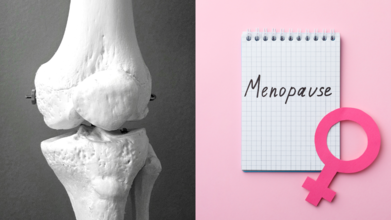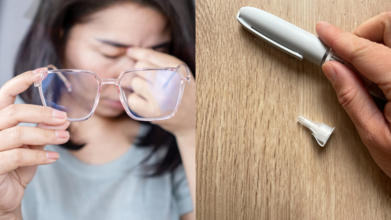- Health Conditions A-Z
- Health & Wellness
- Nutrition
- Fitness
- Health News
- Ayurveda
- Videos
- Medicine A-Z
- Parenting
- Web Stories
Can Birth Control IUDs Cause Depression? Here's How They Are Related

Can Birth Control IUDs Cause Depression? Here's How They Are Related
Birth control plays a crucial role in reproductive health and empowers women to take control and make informed choices in planning families. Among these contraceptive methods, IUDs are known for their effectiveness and convenience. However, recent discussions about their possible effects on mental health, such as depression, have raised concerns.
Could these devices be linked to mood changes or even depression? For those already managing mental health challenges, it is important to understand these possible connections. With conflicting studies and evolving medical insights, understanding how IUDs interact with mood and mental health is crucial for informed decision-making in contraceptive care.
What Are IUDs and How Do They Work?
Intrauterine devices, or IUDs, are small, T-shaped devices inserted into the uterus to prevent pregnancy. The two major types of IUDs are:
1. Copper IUDs: Hormone-free devices that take advantage of the spermicidal properties of copper to prevent pregnancy. They can be used for up to 12 years.
2. Hormonal IUDs: These are devices, which include Kyleena, Mirena, and Skyla. These release levonorgestrel, a synthetic progesterone, and they last from 3 to 7 years depending on the brand.
Although both are more than 99% effective, hormonal IUDs have become controversial because of the potential side effects that could impact mood and mental health.
Potential Connection Between Hormonal IUDs and Depression
Hormonal IUDs work by releasing levonorgestrel, which is responsible for the thickening of cervical mucus and alteration in uterine lining for pregnancy prevention. Despite their effectiveness, reports of mood changes and depressive symptoms have been made.
A 2023 Swedish study involved over 700,000 women and indicated a 57% greater risk of depression by hormonal IUD users, in particular teenagers and women experiencing hormonal contraceptives for the first time. Similarly, research in over a million women found, in 2016, that users of hormonal contraception, with IUD use included in this group, were under a greater prevalence of receiving antidepressants.
Some studies have failed to establish a direct causal link between hormonal IUDs and depression, suggesting that mood changes may stem from other factors, such as individual susceptibility or pre-existing conditions.
Copper vs. Hormonal IUDs
Unlike hormonal IUDs, copper IUDs don't release hormones and thus are less likely to contribute to changes in mood or mental well-being; however, they do sometimes contribute to heavier menstrual flows and cramping, both of which indirectly affect overall well-being.
Hormonal IUDs may cause some individuals to experience mood swings, among other risks, due to hormonal secretion. Everyone reacts differently; therefore, sensitivity to hormone intake and previous medical conditions do count.
Recognizing Depression Symptoms
Awareness about depression is what can be required in the case of controlling adverse effects of IUDs. The following symptoms have to be monitored:
- Continuous sadness or a sense of despair
- Anxiety, irritability, or frustration
- Loss of interest in activities that were once enjoyed
- Changes in sleep or appetite
- Difficulty concentrating
- Fatigue or low energy
Managing Mood Changes
If you believe your IUD is causing mood changes, here are a few things you can do:
- Consult a healthcare provider and further discuss alternative contraception options might be considered if hormonal IUDs are suspected as a potential contributor.
- Treatment may involve therapy, medication, or lifestyle changes. Psychotherapy will be helpful in coping with emotional distress and improving ways to deal with it. When required, antidepressants are also given.
- Regular physical activity, a healthy diet, and mindfulness practices support one's emotional well-being.
- Keep a track of mood fluctuations and have an open communication system with your healthcare provider for timely intervention if needed.
While the potential risk between hormonal IUDs and depression is alarming, such risks should be weighed against its benefits. Hormonal IUDs are highly effective, with additional benefits of reduced symptoms during menstruation. A copper IUD is a good alternative, as it does not contain hormones, but they are not for everyone.
The correlation of IUDs and mental health is complex, so it depends on a case by case basis. A patient will need to consult their physician in order to decide that both their physical and mental needs are met. Thus, you can find an adequate contraceptive method for you given the right guidance.
Your Hormones Could Actually Help Keep Your Bones Strong After Menopause

Credits: Canva
If menopause had a social media profile, its relationship status with women’s health would be… “complicated”. Sure, the hot flashes and mood swings grab most of the headlines, but lurking quietly in the background is another issue: bone loss. Oestrogen is important when it comes to keeping bones strong. Once its levels dip during menopause, women become much more prone to osteoporosis.”
Why Oestrogen Is Crucial
Bone is a living tissue that constantly rebuilds and repairs itself. Oestrogen is what keeps this construction site running smoothly. “When oestrogen drops, the balance between bone building and bone breakdown collapses,” explains Dr. Pramila Kalra, Consultant, Department of Endocrinology, Ramaiah Memorial Hospital. This leads to bones that weaken faster than they can repair.
And it’s not just an invisible problem on a scan. Weakened bones translate into fractures from the most minor of falls. Hips, spines, and wrists are the usual casualties. “To put it into perspective, women over 50 face a 15% lifetime risk of hip fracture, and recovering from one can seriously affect independence,” says Dr. Kalra.
Understanding Hormone Replacement Therapy (HRT)
“HRT replaces the hormones your body no longer produces enough of after menopause, and this can significantly slow down bone loss,” says Dr. Kalra. Not only does it help bones maintain their density, but in some cases, it can even nudge bone strength upwards.
HRT isn’t a one-size-fits-all pill. It comes in forms that suit different lifestyles: tablets, patches, gels, and even sprays. For women with a uterus, progesterone usually joins the prescription party to protect the uterine lining. And along with stronger bones, many women also notice relief from hot flashes, night sweats, and that infamous menopause brain fog.
Is HRT Right for You?
Before you rush to the pharmacy, there are questions worth asking. “HRT works best for women who have severe menopausal symptoms or are at a high risk of osteoporosis,” says Dr. Kalra. Women who experience early menopause, particularly before age 45, are often strong candidates for HRT because their bones face years of oestrogen shortfall.
Safety concerns around HRT have caused plenty of headlines in the past. But newer research has changed the conversation. “When HRT is started within 10 years of menopause and before age 60, the benefits outweigh the risks for most women,” explains Dr. Kalra.
Still, the risks are not zero. There may be a slight increase in the chance of blood clots or breast cancer depending on personal health, the type of HRT, and how long it’s used. “That’s why an individualised discussion with your doctor is crucial. It’s about weighing your personal benefits against possible risks,” she stresses.
A Bigger Bone Health Plan
Dr. Kalra recommends thinking beyond medication. A diet rich in calcium and vitamin D, regular exercise—particularly weight-bearing workouts—and avoiding smoking and excessive alcohol are all essential. “HRT is most effective as part of a holistic bone health plan,” she says.
The Need for Personalised Care
There’s no “universal prescription” for menopause management. “The decision to start HRT must be highly individualised,” advises Dr. Kalra. Your doctor will consider your family history, existing health conditions, and results from a bone density scan. Together, you can discuss the type, dose, and duration of therapy that best fits your needs.
The conversation should cover not just symptoms but also your future risks. “It’s not about erasing menopause—it’s about empowering women to make informed choices so they can stay active and independent for years to come,” says Dr. Kalra.
Menopause may be inevitable, but brittle bones don’t have to be. With the right support, including HRT where appropriate, women can safeguard their bone health and dramatically reduce their risk of fractures. “Think of it as investing in your future mobility and independence,” Dr. Kalra concludes.
Study Reveals Why Autism in Over-40s Rarely Gets Recognised

Credits: Canva
Autism is often painted as a childhood condition, usually spotted in the school playground when social quirks or communication differences raise eyebrows. But what happens when those children grow up without anyone connecting the dots? According to new research from King’s College London, the answer is unsettling: most autistic adults over 40 are still flying under the diagnostic radar.
The review, published in the Annual Review of Developmental Psychology, estimates that a staggering 89 per cent of people over 40 with autism remain undiagnosed. To put that into perspective, while around 23 per cent of autistic children under 19 are missed, nearly 96 per cent of those over 60 have never been recognised as autistic. That’s not just a gap; that’s a canyon.
The Age Factor
When the researchers broke it down by age and gender, the numbers looked even more lopsided. Among men aged 40 to 59, more than 91 per cent had never been diagnosed. For women in the same age group, the figure was almost 80 per cent. By the time people reached their sixties, both men and women crossed into the 96 to 97 per cent range of being undiagnosed.
Compare that with the 20 to 39 age group, where roughly half remained undiagnosed, and the generational divide becomes clear. Today’s younger adults are far more likely to be spotted, assessed and supported. Older adults, meanwhile, have often been left to muddle through without a name for their lifelong differences.
Why It Matters
Gavin Stewart, lead author of the study, explains that a lack of diagnosis means many autistic adults were never offered the right support, leaving them more vulnerable to age-related problems. These range from social isolation to poor physical and mental health.
The review found that autistic people in middle age and beyond have higher rates of almost every health condition compared to non-autistic peers, like heart disease, neurological issues, autoimmune disorders, gastrointestinal problems, anxiety and depression. Add age-related conditions like osteoporosis, arthritis and Parkinson’s disease, and the picture gets even more complicated.
Even more concerning, autistic older adults were six times more likely to report suicidal thoughts or self-harm and four times more likely to develop early-onset dementia.
The Hidden Struggles
The study highlighted another layer of challenge: healthcare itself. Many older autistic adults face obstacles in accessing medical support due to communication differences, sensory sensitivities or simply not knowing how to navigate the system. Combine that with a shortage of healthcare professionals trained in recognising autism in adults, and it’s no wonder so many cases slip through the cracks.
Professor Francesca Happé, co-author of the review, stresses that this is a global public health issue. “Understanding the needs of autistic people as they age is a pressing global public health concern. As autistic people age, the nature of the challenges they face changes. We must adopt a lifespan approach that funds long-term research, integrates tailored healthcare, and expands social supports so that ageing autistic people can live happy and healthy lives,” she says. In other words, autism doesn’t disappear after childhood, so neither should support.
Lost in the Shuffle
The findings also suggest that research into autism may have been skewed for years. If most older adults remain undiagnosed, then studies have largely overlooked them. That means our current understanding of how autistic people age is incomplete at best. No wonder policies and services have not caught up.
Employment struggles, strained relationships and social isolation were all noted as common experiences for older autistic adults. Without the framework of a diagnosis, many never knew why they felt out of step with the world, and their difficulties were often chalked up to personality flaws or “just how they are”.
Why a Diagnosis Still Matters
If you’re wondering whether getting a diagnosis later in life makes a difference, the answer is yes. Recognition can bring clarity, opening doors to support systems, healthcare adaptations and even financial benefits. It can also reshape how family, friends and colleagues understand a person’s behaviour and needs.
The NHS encourages adults who suspect they might be autistic to speak to their GP and ask about a referral for an assessment. Specialists can help by gathering life history, speaking with people who know you well and observing how you interact with others.
A Call for Change
The review ends with a clear message: it’s time to stop treating autism as a childhood-only issue. For too long, older autistic adults have been invisible, their experiences untold and their needs unmet. With diagnosis rates still alarmingly low, researchers are urging more studies, better services and a cultural shift that embraces autism across the lifespan.
Can Diabetes Drugs Steal Your Vision? Why GLP-1s Are Facing Eye Damage Claims

Credits: Canva
When blockbuster diabetes drugs double as miracle weight-loss injections, it seems like everyone wants in. But now, the same medications are making headlines for possible vision loss.
The Double Life of GLP-1 Drugs
Originally designed to regulate blood sugar in type 2 diabetes, GLP-1 receptor agonists, which cover Ozempic, Mounjaro, Wegovy, Trulicity, Rybelsus and others, quickly became famous in the weight-loss world. Social media crowned them the “skinny jab”, while pharmaceutical companies rushed out new versions to keep up with demand.
But as prescriptions soared, so did reports of odd side effects. Stomach paralysis (gastroparesis), intestinal blockages and now a rare vision condition are creeping into the conversation. It turns out shedding pounds might come with strings attached, ones that affect more than your waistline.
A Shadow on the Horizon: NAION
The latest condition in this story is nonarteritic anterior ischaemic optic neuropathy, or NAION for short. It is a mouthful, but the condition itself is no joke. NAION can blur vision permanently or even lead to blindness by damaging the optic nerve.
Whispers of this link first appeared in mid-2024, when Harvard researchers published a study claiming Ozempic users faced a seven-fold higher risk of NAION compared to non-users. Just weeks later, another paper in JAMA Ophthalmology suggested the concern was not limited to Ozempic; it was likely an issue across the entire GLP-1 family.
What the Experts Are Saying
Researchers point out that while there is a measurable increase in eye complications, the story isn’t as clear-cut as it sounds.
A recent retrospective study found a slight but significant uptick, about 7 per cent, in new cases of diabetic retinopathy (DR) among GLP-1 users. DR is a common complication of diabetes itself, where blood vessels in the retina become damaged. Interestingly, though, these same patients did not show a higher risk of progressing to severe complications like proliferative retinopathy or diabetic macular oedema.
Reports suggest that patients on GLP-1 drugs should be screened regularly for eye problems, no matter their baseline status. In other words, keep your ophthalmologist on speed dial.
From Courtrooms to Clinics
While doctors debate the data, lawyers are already busy. Eli Lilly, maker of Mounjaro and Zepbound, has asked federal judges to consolidate the growing pile of lawsuits into one massive multidistrict litigation (MDL). This would lump together claims of optic nerve damage with the thousands of cases already filed over gastroparesis.
The lawsuits accuse manufacturers of pushing profits over patient safety, alleging that the risks of vision loss were downplayed or overlooked. With more patients joining the legal fray, the story is no longer confined to medical journals; it is unfolding in courtrooms across the US.
The Balancing Act for Patients
For people with type 2 diabetes, GLP-1 drugs remain highly effective. They lower blood sugar, help with weight loss, and even offer some protection against heart disease. For many, the benefits still outweigh the risks.
But the newfound spotlight on NAION is a reminder that no drug is without trade-offs. Those weekly injections may slim waistlines, but they also highlight the need for vigilance. Patients should discuss eye health with their doctors, schedule regular check-ups, and report any sudden changes in vision immediately.
© 2024 Bennett, Coleman & Company Limited

